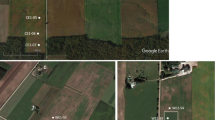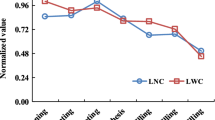Abstract
Variable-rate technologies and site-specific crop nutrient management require real-time spatial information about the potential for response to in-season crop management interventions. Thermal and spectral properties of canopies can provide relevant information for non-destructive measurement of crop water and nitrogen stresses. In previous studies, foliage temperature was successfully estimated from canopy-scale (mixed foliage and soil) temperatures and the multispectral Canopy Chlorophyll Content Index (CCCI) was effective in measuring canopy-scale N status in rainfed wheat (Triticum aestivum L.) systems in Horsham, Victoria, Australia. In the present study, results showed that under irrigated wheat systems in Maricopa, Arizona, USA, the theoretical derivation of foliage temperature unmixing produced relationships similar to those in Horsham. Derivation of the CCCI led to an r 2 relationship with chlorophyll a of 0.53 after Zadoks stage 43. This was later than the relationship (r 2 = 0.68) developed for Horsham after Zadoks stage 33 but early enough to be used for potential mid-season N fertilizer recommendations. Additionally, ground-based hyperspectral data estimated plant N (g kg−1) in Horsham with an r 2 = 0.86 but was confounded by water supply and N interactions. By combining canopy thermal and spectral properties, varying water and N status can potentially be identified eventually permitting targeted N applications to those parts of a field where N can be used most efficiently by the crop.









Similar content being viewed by others
References
Barnes, E. M., Clarke, T. R., & Richards, S. E. (2000). Coincident detection of crop water stress, nitrogen status and canopy density using ground based multispectral data. In P. C. Robert, R. H. Rust, & W. E. Larson (Eds.), Proceedings of the fifth international conference on precision agriculture. Madison, WI, USA: American Society of Agronomy, Unpaginated CD.
Blackmer, T. M., Schepers, J. S., & Varvel, G. E. (1994). Light reflectance compared with other N stress measurements in corn leaves. Agronomy Journal, 86, 934–938.
Carter, G. A., & Spiering, B. A. (2002). Optical properties of intact leaves for estimating chlorophyll concentration. Journal of Environmental Quality, 31(5), 1424–1432.
Clarke, T. R. (1997). An empirical approach for detecting crop water stress using multispectral airborne sensors. Hortechnology, 7(1), 9–16.
Clarke, T. R., Moran, M. S., Barnes, E. M., Pinter P. J. Jr., & Qi, J. (2001). Planar domain indices: A method for measuring a quality of a single component in two-component pixels. In Proceedings IEEE international geoscience and remote sensing symposium, 09–13 July, Sydney, Australia, unpaginated CD.
Daughtry, C. S. T., Walthall, C. L., Kim, M. S., De Colstoun, E. B., & Mcmurtrey, J. E. (2000). Estimating corn leaf chlorophyll concentration from leaf and canopy reflectance. Remote Sensing of Environment, 74(2), 229–239.
Filella, I., & Peñuelas, J. (1994). The red edge position and shape as indicators of plant chlorophyll content, biomass and hydric status. International Journal of Remote Sensing, 15(7), 1459–1470.
Fitzgerald, G. J., Pinter, P. J. Jr., Hunsaker, D. J., & Clarke, T. R. (2005). Multiple shadow fractions in spectral mixture analysis of a cotton canopy. Remote Sensing of Environment, 97, 526–539.
Gao, B.-C. (1996). NDWI – a normalized difference water index for remote sensing of vegetation liquid water from space. Remote Sensing of Environment, 58, 257–266.
Huete, A. (1988). A soil-adjusted vegetation index (SAVI). Remote Sensing of Environment, 25(3), 295–309.
Idso, S. B., Jackson, R. D., Pinter, P. J., Reginatio, R. J., & Hatfield, J. L. (1981). Normalizing the stress-degree-day parameter for environmental variability. Agricultural Meteorology, 24(1), 45–55.
Idso, S. B. (1982). Non-water-stressed baselines: A key to measuring and interpreting plant water stress. Acricultural Meterorology, 27, 59–70.
Isbell, R. F. (1966). The Australian Soil Classification. Melbourne, Australia: CSIRO Publishing, 143 pp.
Jackson, R. D., Idso, S. B., Reginato, R. J., & Pinter, P. J. (1981). Canopy temperature as a crop water stress indicator. Water Resources Research, 17(4), 1133–1138.
Jackson, R. D., Pinter, P. J., Reginato, R. J., & Idso, S. B. (1986). Detection and evaluation of plant stresses for crop management decisions. IEEE Transactions on Geoscience and Remote Sensing, GE, 24(1), 99–106.
Kostrzewski, M., Waller, P., Guertin, P., Haberland, J., Colaizzi, P., Barnes, E., Thompson, T., Clarke, T., Riley, E., & Choi, C. (2002). Ground-based remote sensing of water and nitrogen stress. Transactions of the ASAE, 46(1), 29–38.
Lichtenthaler, H. K., & Wellburn, A. R. (1983). Determination of total carotenoids and chlorophylls a and b of leaf extracts in different solvents. Biochemical Society Transactions, 11, 591–592.
Maas, S. J. (1998). Estimating cotton canopy ground cover from remotely sensed scene reflectance. Agronomy Journal, 90, 384–388.
Maas, S. J. (2000). Linear mixture modelling approach for estimating cotton canopy ground cover using satellite multispectral imagery. Remote Sensing Environment, 72, 304–308.
Maas, S., Fitzgerald, G., & DeTar, W. (2000). Determining cotton leaf canopy temperature using multispectral remote sensing. In Proceedings of the cotton beltwide conferences (pp. 623–626). National Cotton Council, Memphis, TN, USA.
Maracchi, G., Zipoli, G., Pinter, P. J. Jr., & Reginato, R. J. (1988). Water stress effects on reflectance and emittance of winter wheat. In Proceedings of the eighth EARSEL symposium. Capri (Naples), Italy, 17–20 May.
Moran, M. S., Pinter, P. J., Clothier, B. E., & Allen, S. G. (1989). Effects of water stress on the canopy architecture and spectral indices of irrigated alfalfa. Remote Sensing of Environment, 29, 251–261.
Moran, M. S., Clarke, T. R., Inoue, Y., & Vidal, A. (1994). Estimating crop water deficit using the relation between surface-air temperature and spectral vegetation index. Remote Sensing of Environment, 49, 246–263.
Osborne, S. L., Schepers, J. S., Francis, D. D., & Schlemmer, M. R. (2002). Detection of phosphorus and nitrogen deficiencies in corn using spectral radiance measurements. Agronomy Journal, 94, 1215–1221.
Peñuelas, J., Filella, I., Biel, C., Serrano, L., & Save, R. (1993). The reflectance at the 950–970 nm region as an indicator of plant water status. International Journal Remote Sensing, 14(10), 1887–1905.
Peñuelas, J., Gamon, J. A., Fredeen, A. L., Merino, J., & Field, C. B. (1994). Reflectance indices associated with physiological changes in nitrogen – and water limited sunflower leaves. Remote Sensing of Environment, 48, 135–146.
Pettigrew, W. T. (2004). Physiological consequences of moisture deficit stress in cotton. Crop Science, 44, 1265–1272.
Pinter, P. J. Jr., Idso, S. B., Hendrix, D. L., Rokey, R. R., Rauschkolb, R. S., Mauney, J. R., Kimball, B. A., Hendrey, G. R., Lewin, K. F., & Nagy, J. (1994). Effect of free-air CO2 enrichment on the chlorophyll content of cotton leaves. Agricultural and Forest Meteorology, 70, 163–169.
Post, D. F., Mack, C., Camp, P. D., & Sulliman, A. S. (1988). Mapping and characterization of the soils on the University of Arizona, Maricopa Agricultural Center. In Proceedings of hydrology and water resources in Arizona and the Southwest (pp. 49–60). The University of Arizona, Tucson, AZ, USA.
Rodriguez, D., Nuttall, J., Sadras, V., Rees, H. van, & Armstrong, R. (2005a). Impact of subsoil constraints on wheat yield and gross margin on fine-textured soils of the southern Victorian Mallee. Australian Journal of Agricultural Research, 57(3), 335–365.
Rodriguez, D., Sadras, V. O., Christensen, L. K., & Belford, R. (2005b). Spatial assessment of the physiological status of wheat crops as affected by water and nitrogen supply using infrared thermal imagery. Australian Journal Agricultural Research, 56, 983–993.
Rodriguez, D., Fitzgerald, G. J., & Belford, R. (2006). Detection of nitrogen deficiency in wheat from spectral reflectance indices and basic crop eco-physiological concepts. Australian Journal Agricultural Research, 57(7), (in press).
Sadras, V. O., O’Leary, G. J., & Roget, D. K. (2005). Crop responses to compacted soil: Capture and efficiency in the use of water and radiation. Field Crops Research, 91, 131–148.
Strachan, I. B., Pattey, E., & Boisvert, J. B. (2002). Impact of nitrogen and environmental conditions on corn as detected by hyperspectral reflectance. Remote Sensing Environment, 80, 213–224.
Zadoks, J. C., Chang, T. T., & Konzak, C. F. (1974). A decimal code for the growth stages of cereals. Weed Research, 14, 415–421.
Acknowledgments and Disclaimer
The research in Horsham was funded by the Victoria Government, Our Rural Landscape Initiative, Australia. We fully acknowledge Russel Argall and Hemantha Rohitha for their technical assistance at running the field experiment and handling soil and plant samples in Horsham. We would also like to thank the personnel at the U.S. Water Conservation Laboratory for their advice, hard work and dedication. Thanks also are extended to the reviewers who contributed to improving the manuscript. Mention of specific suppliers of hardware and software in this manuscript is for informative purposes only and does not imply endorsement by the United States Department of Agriculture.
Author information
Authors and Affiliations
Corresponding author
Rights and permissions
About this article
Cite this article
Fitzgerald, G.J., Rodriguez, D., Christensen, L.K. et al. Spectral and thermal sensing for nitrogen and water status in rainfed and irrigated wheat environments. Precision Agric 7, 233–248 (2006). https://doi.org/10.1007/s11119-006-9011-z
Published:
Issue Date:
DOI: https://doi.org/10.1007/s11119-006-9011-z




